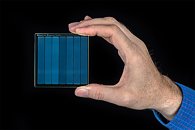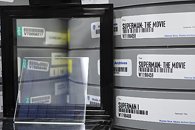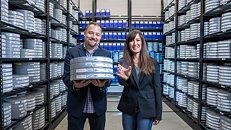- Joined
- Oct 9, 2007
- Messages
- 47,670 (7.43/day)
- Location
- Dublin, Ireland
| System Name | RBMK-1000 |
|---|---|
| Processor | AMD Ryzen 7 5700G |
| Motherboard | Gigabyte B550 AORUS Elite V2 |
| Cooling | DeepCool Gammax L240 V2 |
| Memory | 2x 16GB DDR4-3200 |
| Video Card(s) | Galax RTX 4070 Ti EX |
| Storage | Samsung 990 1TB |
| Display(s) | BenQ 1440p 60 Hz 27-inch |
| Case | Corsair Carbide 100R |
| Audio Device(s) | ASUS SupremeFX S1220A |
| Power Supply | Cooler Master MWE Gold 650W |
| Mouse | ASUS ROG Strix Impact |
| Keyboard | Gamdias Hermes E2 |
| Software | Windows 11 Pro |
Microsoft's cloud computing business unveiled Project Silica, a cold-storage device that's designed to stand the test of time. Essentially an optical storage media, it is a 7.5 cm x 7.5 mm x 2 mm square piece of glass that can store up to 75.6 GB of data (inclusive of error-correction code). Unlike conventional optical media such as CD or Blu-ray, which relies on etching pits of different lengths on a plastic substrate to denote ones and zeros, project silica uses nanoscale gratings and deformations, while AI is used for error-correction to overcome any aging of the media. The company developed a proof-of-concept using quartz glass.
"A laser encodes data in glass by creating layers of three-dimensional nanoscale gratings and deformations at various depths and angles. Machine learning algorithms read the data back by decoding images and patterns that are created as polarized light shines through the glass," writes Microsoft in its description of how Project Silica works. CD can typically hold data for 1-2 centuries provided that the disc is stored properly. After that, the plastic physical layer decays, losing data integrity. Project Silica, on the other hand, is designed to be resilient not just in a box, but also outside it. The media can "withstand being boiled in hot water, baked in an oven, microwaved, flooded, scoured, demagnetized and [withstand] other environmental threats that can destroy priceless historic archives or cultural treasures if things go wrong," says Microsoft.




So what does a cloud computing company have to do with a super-durable optical storage media? Everything. We predict Microsoft could to pitch Project Silica as its proprietary high-endurance cold-storage medium to customers who want it. This will come especially handy for customers like the U.S. Military, which recently contracted Microsoft to build the JEDI Cloud. Project Silica isn't just on paper, Microsoft Azure has been able to successfully store and retrieve the Warner Bros film "Superman" on a proof-of-concept made of quartz glass. The company will work with Warner Bros to eventually copy its vast asset library spanning hundreds of films across thousands of film reels, onto the new media.
View at TechPowerUp Main Site
"A laser encodes data in glass by creating layers of three-dimensional nanoscale gratings and deformations at various depths and angles. Machine learning algorithms read the data back by decoding images and patterns that are created as polarized light shines through the glass," writes Microsoft in its description of how Project Silica works. CD can typically hold data for 1-2 centuries provided that the disc is stored properly. After that, the plastic physical layer decays, losing data integrity. Project Silica, on the other hand, is designed to be resilient not just in a box, but also outside it. The media can "withstand being boiled in hot water, baked in an oven, microwaved, flooded, scoured, demagnetized and [withstand] other environmental threats that can destroy priceless historic archives or cultural treasures if things go wrong," says Microsoft.




So what does a cloud computing company have to do with a super-durable optical storage media? Everything. We predict Microsoft could to pitch Project Silica as its proprietary high-endurance cold-storage medium to customers who want it. This will come especially handy for customers like the U.S. Military, which recently contracted Microsoft to build the JEDI Cloud. Project Silica isn't just on paper, Microsoft Azure has been able to successfully store and retrieve the Warner Bros film "Superman" on a proof-of-concept made of quartz glass. The company will work with Warner Bros to eventually copy its vast asset library spanning hundreds of films across thousands of film reels, onto the new media.
View at TechPowerUp Main Site










